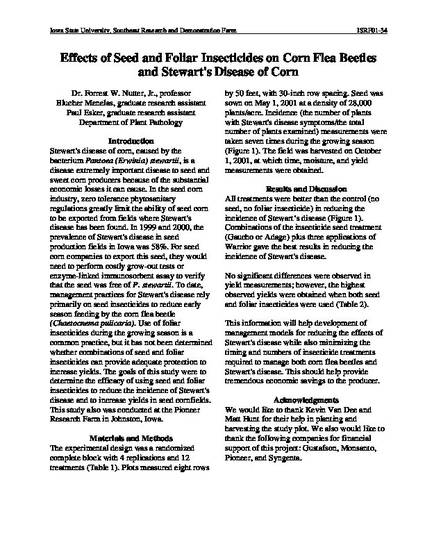
Unpublished Paper
Effects of Seed and Foliar Insecticides on Corn Flea Beetles and Stewart's Disease of Corn
Iowa State Research Farm Progress Reports
Farm
Southeast Research and Demonstration Farm
Publication Date
1-1-2002
Disciplines
Abstract
Stewart's disease of corn, caused by the bacterium Pantoea (Erwinia) stewartii, is a disease extremely important disease to seed and sweet corn producers because of the substantial economic losses it can cause. In the seed corn industry, zero tolerance phytosanitary regulations greatly limit the ability of seed corn to be exported from fields where Stewart's disease has been found. In 1999 and 2000, the prevalence of Stewart's disease in seed production fields in Iowa was 58%. For seed corn companies to export this seed, they would need to perform costly grow-out tests or enzyme-linked immunosorbent assay to verify that the seed was free of P. stewartii. To date, management practices for Stewart's disease rely primarily on seed insecticides to reduce early season feeding by the corn flea beetle (Chaetocnema pulicaria). Use of foliar insecticides during the growing season is a common practice, but it has not been determined whether combinations of seed and foliar insecticides can provide adequate protection to increase yields. The goals of this study were to determine the efficacy of using seed and foliar insecticides to reduce the incidence of Stewart's disease and to increase yields in seed cornfields. This study also was conducted at the Pioneer Research Farm in Johnston, Iowa.
Copyright Owner
Iowa State University
Copyright Date
2002
Language
en
File Format
application/pdf
Citation Information
Forrest W. Nutter, Blucher Menelas and Paul Esker. "Effects of Seed and Foliar Insecticides on Corn Flea Beetles and Stewart's Disease of Corn" (2002) Available at: http://works.bepress.com/forrest_nutter/4/
